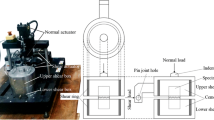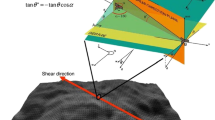Abstract
The three-dimensional (3D) morphology of a rock joint has a great impact on its shear behavior. To study the relationship between the 3D morphological characteristics and the peak shear strength, several tilt tests were conducted on four groups of tensile fractures and direct shear tests were carried out under different constant normal loads (CNL). The normal load ranges from 0.325 to 8.0 MPa. In this study, fresh tensile fractures which were splitted from granite and sandstone samples were used. The morphology of each tensile fracture was measured before direct shear tests. A new peak shear strength criterion for rock joints is proposed using two 3D morphological parameters which are termed as the maximum apparent dip angle \(\theta_{\max}^{*}\) and the roughness parameter C. The calculated peak strengths using the proposed criterion match well with the observed values. In addition, a comparison of the proposed model with the Grasselli’s model (2003) and Xia’s model (2014) shows that the proposed model is easier in the form and gives a rational improvement. At last, direct shear test data of tensile fractures which are collected from Grasselli (2003) are used to verify the proposed model. It is seen that the proposed model has a reliable estimate of the peak shear strength of tensile fractures and presumably for rock joints.














Similar content being viewed by others
Abbreviations
- A 0 :
-
Maximum potential contact area ratio for the specified shear direction
- A t :
-
Sum of area facing to the shear direction (mm2)
- A :
-
Total fracture surface area (mm2)
- \(\theta_{\max}^{*}\) :
-
Maximum apparent dip angle in the shear direction (°)
- C :
-
Roughness parameter characterizing the distribution of apparent dip angles over the fracture surface
- \(\theta_{\text{cr}}^{*}\) :
-
Threshold apparent dip angle (°)
- θ :
-
Dip angle of the triangular element (°)
- t :
-
The shear vector
- n :
-
Outward normal vector of the triangle element
- n 1 :
-
The projection vector of n
- α :
-
The angle between n 1 and t, measured clockwise from t (°)
- JRC:
-
Joint roughness coefficient
- JCS:
-
Joint wall compressive strength (MPa)
- UCS:
-
Uniaxial compressive strength (MPa)
- τ p :
-
Peak shear strength (MPa)
- σ n :
-
Applied normal stress (MPa)
- σ t :
-
Tensile strength (MPa)
- φ b :
-
Basic friction angle (°)
- φ r :
-
Residual friction angle (°)
- d n :
-
Peak dilatancy angle (°)
- s n :
-
Represents failure of intact material (°)
- \(\phi_{\text{p}}\) :
-
Total friction angle (°)
- \(\alpha_e^0\) :
-
Initial effective asperity angle (°)
- α e :
-
Effective asperity angle (°)
- b :
-
A material parameter
- β :
-
Angle between the schistosity plane and the plane normal to the joint (°)
- \(\bar{\sigma}_{\text{ave}}\) :
-
Average estimate error
- τ mea :
-
Measured peak shear strength (MPa)
- τ cal :
-
Calculated peak shear strength by the criteria (MPa)
- m:
-
Number of samples
References
Aydan Ö, Shimizu Y, Kawamoto T (1996) The anisotropy of surface morphology characteristics of rock discontinuities. Rock Mech Rock Eng 29(1):47–59
Bandis S, Lumsden A, Barton N (1981) Experimental studies of scale effects on the shear behaviour of rock joints. Int J Rock Mech Min Sci Geomech Abstr 18(1):1–21
Barton N (1971) A relationship between joint roughness and joint shear strength. Int Symp Rock Mech Rock Fracture, Nancy, pp 1–8
Barton N (1973) Review of a new shear-strength criterion for rock joints. Eng Geol 7(4):287–332
Barton N (1982) Modelling rock joint behavior from in situ block tests: implications for nuclear waste repository design. Office of Nuclear Waste Isolation, Columbus, Ohio, ONWI-308
Barton N, Choubey V (1977) The shear strength of rock joints in theory and practice. Rock Mech 10(1–2):1–54
Belem T, Homand-Etienne F, Souley M (2000) Quantitative parameters for rock joint surface roughness. Rock Mech Rock Eng 33(4):217–242
Ferrero M, Iabichino G, Pancotti G, Giani G (1999) Interpretazione con modelli matematici di misure di rugosità di discontinuità naturali in roccia. XX convegno nazionale di geotecnica, Parma, pp 101–106
Gens A, Carol I, Alonso E (1990) A constitutive model for rock joints formulation and numerical implementation. Comp Geotech 9(1):3–20
Gentier SS, Hopkins DL (1997) Mapping fracture aperture as a function of normal stress using a combination of casting, image analysis and modeling techniques. Int J Rock Mech Min Sci 34(3–4):132
Gentier S, Riss J, Archambault G, Flamand R, Hopkins D (2000) Influence of fracture geometry on shear behavior. Int J Rock Mech Min Sci 37(1):161–174
Ghaboussi J, Wilson EL, Isenberg J (1973) Finite element for rock joints and interfaces. J Soil Mech Found Div 99(10):849–862
Ghazvinian A, Taghichian A, Hashemi M, Mar’ashi S (2010) The shear behavior of bedding planes of weakness between two different rock types with high strength difference. Rock Mech Rock Eng 43(1):69–87
Grasselli G (2001) Shear strength of rock joints based on quantified surface description. Ph.D dissertation, Lausanne, Switzerland, Swiss Federal Institute of Technology
Grasselli G (2006) Manuel Rocha medal recipient shear strength of rock joints based on quantified surface description. Rock Mech Rock Eng 39(4):295–314
Grasselli G, Egger P (2000) 3D surface characterization for the prediction of the shear strength of rough joints. In: Proceedings of Eurock 2000, Aachen, Germany, pp 281–286
Grasselli G, Egger P (2003) Constitutive law for the shear strength of rock joints based on three-dimensional surface parameters. Int J Rock Mech Min Sci 40(1):25–40
Grasselli G, Wirth J, Egger P (2002) Quantitative three-dimensional description of a rough surface and parameter evolution with shearing. Int J Rock Mech Min Sci 39(6):789–800
Homand F, Belem T, Souley M (2001) Friction and degradation of rock joint surfaces under shear loads. Int J Numer Anal Methods Geomech 25(10):973–999
Hsu-Jun K (1979) Non-linear analysis of the mechanical properties of joint and weak intercalation in rock. In: Proceedings of 3rd International Conference on Numerical Methods in Geomechanics, pp, 523–532
ISRM (1978) Suggested methods for the quantitative description of discontinuities in rock masses. Int J Rock Mech Min Sci Geomech Abstr 15(6):319–368
Jaeger J (1971) Friction of rocks and stability of rock slopes. Geotechnology 21(2):97–134
Jing L (1990) Numerical modelling of jointed rock masses by distinct element method for two-and three-dimensional problems. Ph.D dissertation, Sweden, Lulea, Lulea University of Technology
Jing L, Nordlund E, Stephansson O (1992) An experimental study on the anisotropy and stress-dependency of the strength and deformability of rock joints. Int J Rock Mech Min Sci Geomech Abstr 29(6):535–542
Jing L, Stephansson O, Nordlund E (1993) Study of rock joints under cyclic loading conditions. Rock Mech Rock Eng 26(3):215–232
Kulatilake P, Shou G, Huang T (1995a) Spectral-based peak-shear-strength criterion for rock joints. J Geotechnol Eng 121(11):789–796
Kulatilake P, Shou G, Huang T, Morgan R (1995b) New peak shear strength criteria for anisotropic rock joints. Int J Rock Mech Min Sci Geomech Abstr 32(7):673–697
Kulatilake P, Um J, Panda B, Nghiem N (1999) Development of new peak shear-strength criterion for anisotropic rock joints. J Eng Mech 125(9):1010–1017
Ladanyi B, Archambault G (1969) Simulation of the shear behaviour of a jointed rock mass. In: Proceeding of the 11th US symposium on rock mechanics 7:105–125
Lanaro F, Jing L, Stephansson O (1998) 3-D-laser measurements and representation of roughness of rock fractures. In: Proceedings of Mechanical Jointed Faulted Rock. Vienna, pp 185–189
Lee H, Park Y, Cho T, You K (2001) Influence of asperity degradation on the mechanical behavior of rough rock joints under cyclic shear loading. Int J Rock Mech Min Sci 38(7):967–980
Li B, Jiang Y, Koyama T, Jing L, Tanabashi Y (2008) Experimental study of the hydro-mechanical behavior of rock joints using a parallel-plate model containing contact areas and artificial fractures. Int J Rock Mech Min Sci 45(3):362–375
Mah J, Samson C, McKinnon SD, Thibodeau D (2013) 3D laser imaging for surface roughness analysis. Int J Rock Mech Min Sci 58:111–117
Maksimović M (1992) New description of the shear strength for rock joints. Rock Mech Rock Eng 25(4):275–284
Maksimović M (1996) The shear strength components of a rough rock joint. Int J Rock Mech Min Sci Geomech Abstr 33(8):769–783
Patton FD (1966) Multiple modes of shear failure in rock. In: Proceeding of First congress of ISRM, Lisbon, Portugal 1:509–513
Plesha ME (1987) Constitutive models for rock discontinuities with dilatancy and surface degradation. Int J Numer Anal Methods Geomech 11(4):345–362
Roberds WJ, Einstein HH (1978) Comprehensive model for rock discontinuities. J Geotechnol Geoenvi Eng 104:553–569
Roosta RM, Sadaghiani MH, Pak A, Saleh Y (2006) Rock joint modeling using a visco-plastic multilaminate model at constant normal load condition. Geotechnol Geol Eng 24(5):1449–1468
Saeb S, Amadei B (1992) Modelling rock joints under shear and normal loading. Int J Rock Mech Min Sci Geomech Abstr 29(3):267–278
Schneider H (1976) The friction and deformation behaviour of rock joints. Rock Mech 8(3):169–184
Serrano A, Olalla C, Galindo R (2014) Micromechanical basis for shear strength of rock discontinuities. Int J Rock Mech Min Sci 70:33–46
Son BK, Lee YK, Lee CI (2004) Elasto-plastic simulation of a direct shear test on rough rock joints. Int J Rock Mech Min Sci 41:354–359
Tang Z, Xia C, Song Y, Liu T (2012) Discussion about Grasselli’s peak shear strength criterion for rock joints. Chin J Rock Mech Eng 31(2):356–364 (in Chinese with English abstract)
Tatone BS, Grasselli G (2009) A method to evaluate the three-dimensional roughness of fracture surfaces in brittle geomaterials. Rev Sci Instrum 80(12):125110
Tatone BS, Grasselli G (2013) An investigation of discontinuity roughness scale dependency using high-resolution surface measurements. Rock Mech Rock Eng 46(4):657–681
Xia CC, Tang ZC, Xiao WM, Song YL (2014) New peak shear strength criterion of rock joints based on quantified surface description. Rock Mech Rock Eng 47(2):387–400
Yang Z, Lo S (1997) An index for describing the anisotropy of joint surfaces. Int J Rock Mech Min Sci 34(6):1031–1044
Zhang P, Ning L, Xinmin C (2009) A new representation method for threedimensional surface roughness of rock fracture. Chin J Rock Mech Eng 28(3):477–483 (in Chinese with English abstract)
Zhao J (1997) Joint surface matching and shear strength part B: JRC-JMC shear strength criterion. Int J Rock Mech Min Sci 34(2):179–185
Acknowledgments
The research work presented in this paper is supported by the National Basic Research Program of China (“973” Program, grant no. 2011CB013501), the National Natural Science Foundation of China (Grant No. 50979081) and the Program for New Century Excellent Talents in University (grant no. NCET-11-0406). The authors are grateful for these financial supports. We are immensely grateful to the anonymous reviewers for their constructive comments and suggestions to improve this paper.
Author information
Authors and Affiliations
Corresponding author
Rights and permissions
About this article
Cite this article
Yang, J., Rong, G., Hou, D. et al. Experimental Study on Peak Shear Strength Criterion for Rock Joints. Rock Mech Rock Eng 49, 821–835 (2016). https://doi.org/10.1007/s00603-015-0791-1
Received:
Accepted:
Published:
Issue Date:
DOI: https://doi.org/10.1007/s00603-015-0791-1




